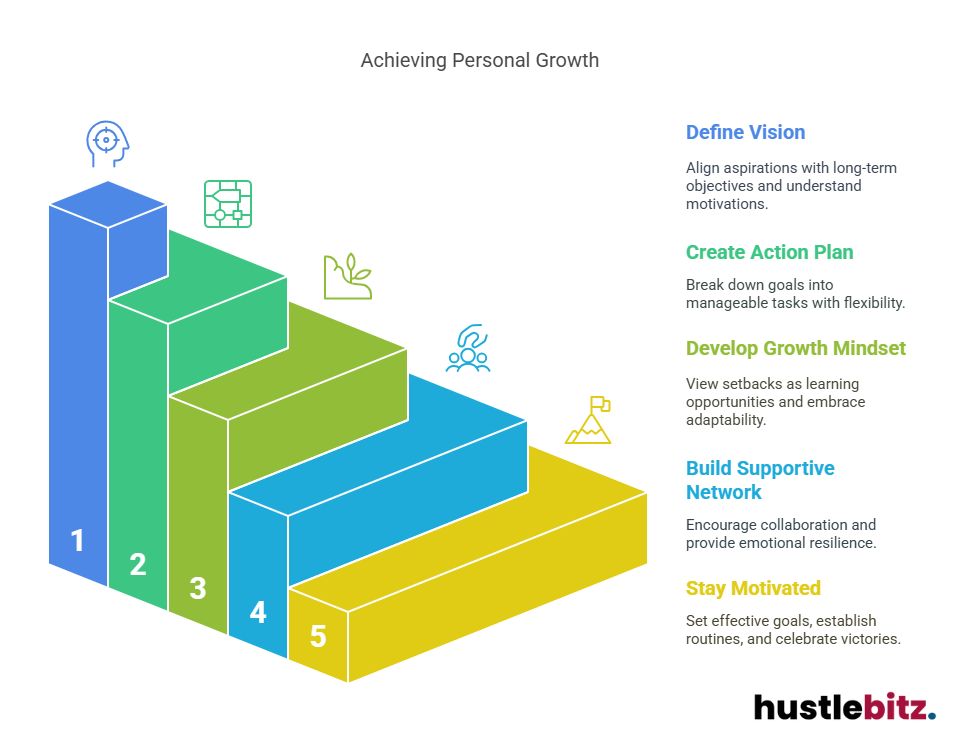Achieving your goals demands a structured approach focused on several key strategies. Begin by defining your vision, which provides clear direction and purpose. Create a detailed action plan that breaks down objectives into manageable tasks and prioritizes them. Developing a growth mindset is essential for viewing setbacks as learning opportunities. Overcoming obstacles requires resilience and effective time management. Staying motivated involves setting clear goals, establishing routines, and maintaining a supportive network. Lastly, embrace failures as vital growth experiences. By understanding these strategies, you pave the way to success, opening the door to additional insights and techniques that can further enhance your journey.
Key Takeaways
- Clearly define your vision to align aspirations with long-term objectives and understand your intrinsic motivations.
- Create a detailed action plan that breaks down goals into manageable tasks and incorporates flexibility for adjustments.
- Develop a growth mindset by viewing setbacks as learning opportunities and embracing continuous learning and adaptability.
- Build a supportive network of peers and mentors to encourage collaboration and provide emotional resilience during challenges.
- Stay motivated by setting effective goals, establishing routines, and celebrating small victories to reinforce commitment.

Defining Your Vision
Defining your vision is the crucial first step in the goal-setting process, as it establishes a clear and compelling direction for your aspirations. Vision clarity is paramount; it enables you to see beyond immediate challenges and align your goals with your long-term objectives. By engaging in purpose identification, individuals can cultivate an understanding of their intrinsic motivations, which serves as the bedrock for a meaningful life trajectory.
Future mapping is an essential exercise in this phase, allowing you to visualize the path toward your envisioned future. This practice not only reinforces your mission statement but also acts as a visual representation of your aspirations, ensuring that every goal you set is in harmony with your personal values. An aspirational mindset is fostered through this process, empowering you to embrace challenges as stepping stones rather than obstacles.
Moreover, strategic foresight is critical in defining your vision. It involves anticipating potential barriers and identifying opportunities that resonate with your purpose. By integrating these elements, you can achieve comprehensive goal alignment, ensuring that each objective contributes to your overarching vision. This alignment enhances motivation and focus, steering you toward success with unwavering determination.
Creating an Action Plan

An effective action plan serves as a roadmap, detailing the specific steps required to transform your vision into achievable goals. Crafting such a plan necessitates deploying actionable steps that ensure efficiency and clarity. Begin by delineating your objectives and breaking them down into smaller, manageable tasks. This process promotes effective time management and resource allocation, allowing for optimal use of available assets.
In your action plan, prioritize tasks based on urgency and importance through priority setting. Establish accountability measures by assigning responsibilities to relevant team members, thereby fostering team collaboration and ensuring that everyone is invested in the collective goal. Milestone tracking is essential for monitoring progress, as it provides tangible indicators of advancement towards your objective.
Flexibility adaptation should also be embedded in your plan, allowing for adjustments in response to unforeseen challenges. Regular progress evaluation is critical; it enables you to assess the effectiveness of your strategies and modify them as necessary. Lastly, enforce deadlines to maintain momentum and foster a culture of accountability.
Here is a simple framework to illustrate the components of an effective action plan:
| Component | Description | Purpose |
| Actionable Steps | Clearly defined tasks and objectives | To ensure clarity |
| Accountability Measures | Designation of responsibilities to team members | To promote ownership |
| Milestone Tracking | Regular check-ins and evaluations of progress | To monitor advancement |
Developing a Growth Mindset

Building on the foundation of an effective action plan, developing a growth mindset is pivotal for overcoming obstacles and embracing challenges as opportunities for learning and improvement. A growth mindset fosters positive thinking, enabling individuals to view setbacks as stepping stones rather than roadblocks. This perspective is essential for resilience building, as it encourages a proactive approach to adversity.
Embracing challenges is a critical component of a growth mindset. When faced with difficulties, individuals with this mindset employ self-reflection techniques to analyze their experiences and extract valuable lessons. This continuous learning process not only enhances adaptability skills but also strengthens emotional intelligence, allowing one to navigate complex situations with greater ease.
Moreover, cultivating a goal-oriented mindset requires the acceptance of constructive feedback. Individuals who actively seek and implement feedback demonstrate a commitment to personal growth, reinforcing their belief in their capacity to improve. This openness to external insights complements the internal drive for excellence that characterizes those with a growth mindset.
Overcoming Obstacles
Overcoming obstacles requires a strategic approach that combines resilience, adaptability, and a proactive mindset to navigate challenges effectively. The journey toward achieving your goals is often fraught with setbacks and barriers. Therefore, developing a robust framework for overcoming these obstacles is essential for sustained success.
Key strategies for overcoming obstacles include:
- Resilience Building: Cultivating the ability to bounce back from difficulties enhances emotional intelligence and fosters a growth mindset.
- Fear Management: Acknowledging fears and learning to manage them is crucial for maintaining focus and determination in the face of adversity.
- Time Management: Efficiently allocating time to tasks helps mitigate stress and allows for better preparation against unexpected challenges.
- Resourcefulness Training: Developing resourcefulness equips individuals with the skills to find innovative solutions when traditional methods fail.
Incorporating these strategies not only aids in immediate problem-solving but also fosters long-term adaptability skills.
Mindset shifts play a pivotal role in viewing obstacles as opportunities for growth rather than insurmountable barriers. Integrating supportive networks can provide additional emotional and practical resources, mitigating stress and enhancing resilience.
Employing effective problem-solving techniques will enable you to dissect challenges, identify underlying issues, and formulate actionable plans.
Together, these strategies create a comprehensive approach to overcoming obstacles, facilitating personal and professional mastery in your pursuit of success.
Staying Motivated

Maintaining motivation is essential for consistently progressing toward your goals, especially when faced with challenges and setbacks. To cultivate sustained enthusiasm, effective goal setting is paramount; clearly defined objectives provide a roadmap that enhances focus and direction.
Implementing daily routines that incorporate time management strategies can further streamline efforts, ensuring that each action aligns with your overarching ambitions.
Utilizing visual reminders, such as vision boards or strategic notes, can reinforce your commitment to these goals. Complementing this with positive affirmations cultivates a growth mindset, allowing you to approach obstacles with resilience and optimism.
Engaging with accountability partners can significantly enhance motivation. By sharing your aspirations with others, you create a network of support that encourages progress tracking and fosters mutual encouragement. This collaborative dynamic can also help you refine your path, as feedback from partners can offer new perspectives.
Incentivizing your journey through reward systems can bolster motivation significantly. Recognizing milestones with tangible rewards reinforces positive behaviors and cultivates a sense of accomplishment.
Additionally, integrating self-care practices into your routine ensures that you maintain mental and physical well-being, which is crucial for sustaining motivation over the long term.
Lastly, surrounding yourself with inspirational quotes can serve as a powerful reminder of your purpose, invigorating your spirit when motivation wanes. By weaving these strategies into your pursuit, you can master the art of staying motivated, ultimately propelling yourself toward success.
Learning From Failures

Experiencing setbacks is an inevitable part of the journey toward achieving goals, and understanding how to learn from these failures can significantly enhance future success.
Embracing setbacks is crucial; they provide valuable opportunities for growth. By analyzing mistakes, individuals can identify lessons that inform future actions and decisions. This process fosters resilience, enabling one to navigate the complexities of goal pursuit with greater fortitude.
To effectively learn from failures, consider the following strategies:
- Reframing challenges: Shift your perspective to see failures as stepping stones rather than obstacles.
- Leveraging feedback: Actively seek constructive criticism from peers and mentors to refine your approach.
- Celebrating progress: Acknowledge small victories along the way to build confidence and motivation.
- Cultivating patience: Understand that mastery takes time; setbacks are a natural part of the learning curve.
Additionally, maintaining perspective is essential. This involves recognizing that failures do not define your capabilities but rather contribute to your personal and professional development.
Seeking support from your network can also provide encouragement and alternative viewpoints that facilitate growth. Ultimately, the key lies in identifying lessons from each experience, reinforcing the notion that setbacks are not the end but integral components of the success journey.
Final thoughts
Achieving long-term success requires a combination of vision, planning, resilience, and continuous learning. By staying adaptable, motivated, and open to feedback, individuals can overcome obstacles and turn failures into valuable lessons. Success isn’t just about reaching the goal; it’s about the journey and growth along the way.




